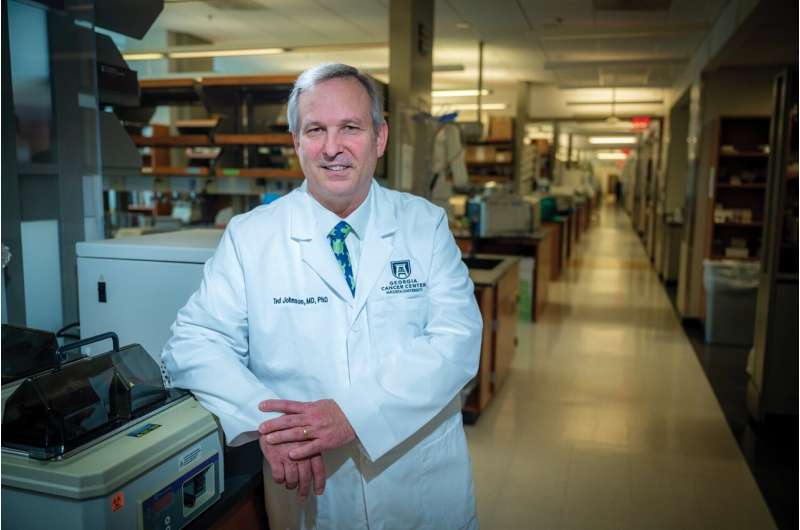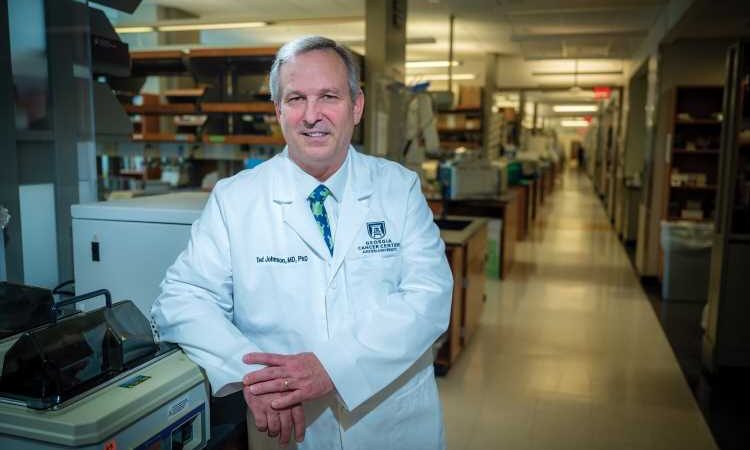
The first in-human-study of a new immunotherapy that blocks a natural enzyme tumors commandeer for their protection was well tolerated by children with relapsed brain tumors and enabled many to have unexpected months of a more normal life, researchers say.
“Our kids were by and large out of the hospital and going about their daily activities. They were in school, we had young adults who were in college living in a dorm on their own, taking their medicine on their own and coming to see us once a month,” says Theodore S. Johnson, MD/Ph.D., pediatric hematologist/oncologist and co-director of the Pediatric Immunotherapy Program at Children’s Hospital of Georgia and the Georgia Cancer Center.
The phase 1 trial of indoximod plus chemotherapy and/or radiation therapy, started in 2015 at CHOG and Children’s Hospital of Atlanta. Researchers enrolled 81 children ages 3 to 21 from across the country with all types of brain tumors that had relapsed or never resolved, which is called progression. About midway through the trial, the researchers added children newly diagnosed with a rare, aggressive diffuse intrinsic pontine glioma, or DIPG, which can’t be treated surgically and for which there is currently no treatment considered curative.
Johnson presented an analysis of the safety, tolerability and five-year outcomes of the phase 1 trial during the American Academy of Neurology Annual Meeting April 22-27 in Boston.
Indoximod inhibits IDO, or indoleamine 2,3 dioxygenase, an enzyme both fetuses and brain tumors use to hide from the immune system. The IDO inhibitor helps prevent the tumor from using IDO to suppress the natural response of the immune system to an invader like a tumor. Johnson notes that IDO-inhibitors do not work alone, rather, as with the trial, in combination with chemotherapy, radiation or targeted therapy, which target molecular mechanisms tumors use to grow.
Assessing the safety and optimal dose of the indoximod was the primary endpoint of this and other phase 1 trials, Johnson notes. A follow-on phase 2 trial with a focus on efficacy and funded in part by the National Cancer Institute already is underway once again at CHOG and CHOA, as well as Cincinnati Children’s Hospital and Dana Farber Cancer Institute in Boston.
While the majority of the children in the phase 1 trial experienced some side effects like vomiting and anemia, the majority of the side effects were mild; the most serious side effects, including cardiac arrest and stroke, were directly attributable to brain tumor progression, Johnson and his colleagues report.
They approached the study with quality of life for the children top of mind. “We structured the treatment so the chemotherapy would not be highly intensive, and it’s all oral chemotherapy,” Johnson says. “It’s not the same intensity as those high-dose intravenous regimens that drive a lot of severe side effects and very low blood counts that make you need transfusions, make you susceptible to infection and put you in the hospital for infections and other things.”
Several of the young patients in the first-phase trial were already taking temozolomide, a chemotherapy drug commonly prescribed for brain tumors, and their tumors were progressing. But adding the IDO inhibitor to their regimen created a whole new treatment, Johnson says.
“It helps bring the immune system into play. A combination seems to be better because you are hitting the tumor with drugs with different mechanisms of action,” Johnson says, a common approach in today’s cancer treatment. “And, of course, the idea of the IDO inhibitor therapy is we hope to unleash a more powerful immune response.”
The researchers are still analyzing and planning to publish laboratory findings on the overall immune response from the treatment regimen. Detailed, high-throughput immune testing on the DIPG patients indicated a marked increase in the activity of immune cells called T cells, key drivers of the immune response, after staring treatment that included the IDO inhibitor-based therapy.
The median survival time in the trial was 13.6 months, while the median survival for children in relapse with the brain tumor types included in the study is about six months, according to the latest literature. A handful of study patients are still alive five years off the study, Johnson says, and one is still on the therapy.
The children with DIPG had a median survival of 14.4 months, Johnson says. Most children with DIPG are diagnosed before age 7 and live about 9 to 11 months after diagnosis. Because of the small number of children with DIPG enrolled, the results could not be considered statistically significant, meaning a clear correlation between the treatment and the survival time could not be made for the DIPG patients.
“Patterns of response for study participants ranged from relentlessly growing tumors with some kids not even getting the second cycle of treatment to kids who immediately had a shrinking tumor that stayed gone for a period of time,” Johnson says. He notes that just stabilizing one of these tumors is significant because a growing tumor in the brain wants to keep growing, which can wreak havoc with your neurological system, robbing fundamental functions like the ability to walk, talk and swallow. Some patients in the study recovered these basic abilities over time.
For this trial, the researchers did not draw hard lines about when treatment should stop. The children stayed on their treatment as long as it was beneficial, and as long as their symptoms permitted. Some children, for example, eventually lost the ability to swallow, which was essential to pill taking. Those late-stage type symptoms indicate the tumor is putting pressure on important parts of the brain making any treatment problematic, he says. But overall the median survival was better than would be expected for late-stage, relapsed tumors, he reiterates.
The study also had the flexibility to switch chemotherapy drugs when needed if the tumor had become resistant, called adaptive management, and this allowed patients to continue with the immunotherapy. They had 18 patients switch to an alternative chemotherapy regimen plus indoximod and the median overall survival for that group was 34.7 months.
“Switching the chemotherapy clearly made an impact in that group but it needs to be studied in more detail,” Johnson says, with more patients with the same tumor type—a goal of the phase 2 study that is underway—to ensure they did not just happen to get patients who were particularly sensitive to the second chemotherapy regimen.
The cancer also can become resistant to immunotherapy, which is why the researchers began looking for another immunotherapy with a different path of action than indoximod. That led to a new phase 1 trial, which is pairing indoximod with a second immunotherapy drug ibrutinib plus chemotherapy. “We think it will magnify the immune effects in a synergistic way,” Johnson says.
Palliative radiation, surgery or the corticosteroid dexamethasone, which may be used to treat fluid buildup in the brain, also were permitted as needed by patients.
Overall the phase 1 trial was “absolutely” a success, Johnson says, noting that while pediatric phase 1 trials are typically hard to recruit for they were able to enroll their target of 81 kids in three years. Also, the vast majority of phase 1 trials don’t have findings sufficient to support moving to phase 2.
“The phase 1 trial met its goals of delivering the treatment safely, proving that the treatment in combination with chemotherapy and radiation is feasible and in determining the best, safe dose of indoximod for both of those combinations,” Johnson says.
David Munn, MD, Johnson’s colleague who is co-director of the Pediatric Immunotherapy Program, was part of the team that reported in 1998 in the journal Science that the placenta expresses IDO to help protect the fetus, which has DNA from both parents, from the mother’s immune response. The MCG researchers would later find that tumors induce IDO as well, likely from the immune system itself, which produces the enzyme as part of a natural check and balance.
Brain tumors are the most common tumor in children and leukemia the most common cancer, according to the American Cancer Society.
Other tumor types in the phase 1 trial included ependymoma, a tumor that begins in the cells that line the passageway for cerebrospinal fluid in the brain and spinal cord; medulloblastoma, which tends to start at the base of the brain and spread to other areas of the brain and spinal cord; and glioblastoma, a fast-growing tumor that develops in the brain cells that support neurons.
More information:
Pediatric Trial of Indoximod With Chemotherapy and Radiation for Relapsed Brain Tumors or Newly Diagnosed DIPG,
Journal information:
Science
Source: Read Full Article
